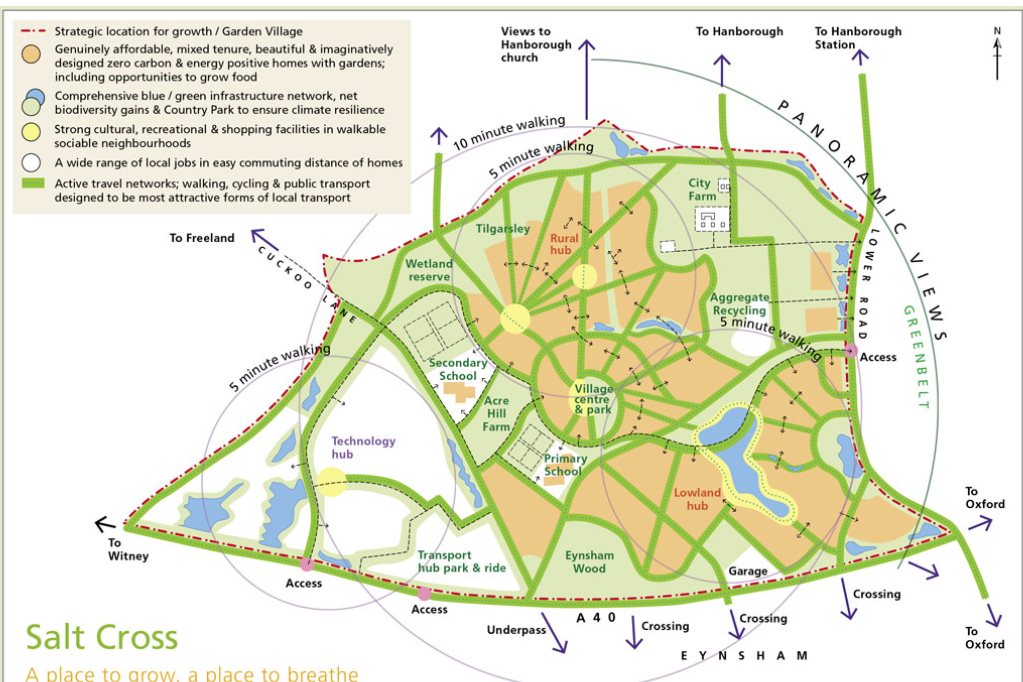Salt Cross examination – an important week for net-zero standards in new developments
What’s Happening at Salt Cross?
Many local residents will be aware that Salt Cross is a proposed garden village, consisting of 2,200 homes and employment space, and located north of the A40 across from Eynsham.
To guide this major development, West Oxfordshire District Council created a strong and ambitious planning policy, known as Policy 2 – Net-Zero Carbon Development. This policy is part of an Area Action Plan (AAP) and is based on Garden City principles, as well as forward-thinking approaches to the circular economy and climate change.

In 2021, the Planning Inspectorate reviewed this policy during a formal Examination. Their report, published in 2023, removed key climate targets from the AAP.
This decision was challenged in the High Court by Rights Community Action. As a result, a draft order in March 2024 confirmed that the Inspector’s report and the proposed changes were quashed, specifically where they related to Policy 2.
A new Examination will now take place on 30 June, with a backup session scheduled for 4 July. This will reconsider Policy 2 and related updates to the AAP. The District Council and Rights Community Action will argue for the reinstatement of the original policy. In contrast, Grosvenor, representing the landowners, will oppose this.
While this may seem like a technical debate, the outcome is highly important—both locally and nationally—as it affects people’s lives and how we respond to the climate emergency.
The Examination will cover a range of complex issues, including:
- Alignment with national planning policy
- Methods for measuring carbon emissions
- Commercial and financial viability
You can find more details on the District Council’s website.
If Policy 2 is reinstated, Salt Cross residents will benefit from:
- Well-insulated homes
- Low heating bills
- Comfortable indoor temperatures all year round
- Minimal extra building costs
If it is not reinstated, homes will need to be retrofitted later to meet environmental standards—an approach that is less effective and much more expensive.
What will the Salt Cross ruling mean for CAPZero?
The Community Action Plan for Zero-Carbon Energy (CAPZero) states that all new houses should be built to LETI standards. You can read about LETI standards, and why the plan uses them, here. The Salt Cross development is within the CAPZero area, and it is essential that these new homes are built to the higher building standards set out by the local authority in their AAP, to avoid the need for costly retrofit in the area, and enable the achievement of the plan’s net zero targets.
In addition to the obvious ramifications for the local area, this process has the potential to set a precendent for developments across England, empowering local authorities to be ambitious in their requirements for new developments.
What can you do to support the reinstatement of a more ambitious planning policy?

- Donate to the crowdfunder supporting the legal process, organised by Rights Community Action: Support our fight to let local areas plan for climate change
- Follow the case live as it happens: watch Rights Community Action challenge the Written Ministerial Statement (WMS), a policy that effectively blocks local authorities from setting higher environmental standards for new housing developments than those set by national regulations. The hearing will be livestreamed by the Court of Appeal and available to watch online via the official Judiciary website here: watch the hearing
- Get involved in community-led action for the environment: join Eynsham-based GreenTEA, Freeland Energy Group or Go Green Hanborough
- Stay up to date: get the latest updates on the West Oxfordshire District Council website and join the CAPZero mailing list to be kept up to date of this and other relevant developments in the area. You can also follow Rights Community Action on instagram
- Get information: find out blog about LETI standards, check out the LETI website, or head to our glossary
With thanks to GreenTEA Chair Tony Bovey for much of the article.
